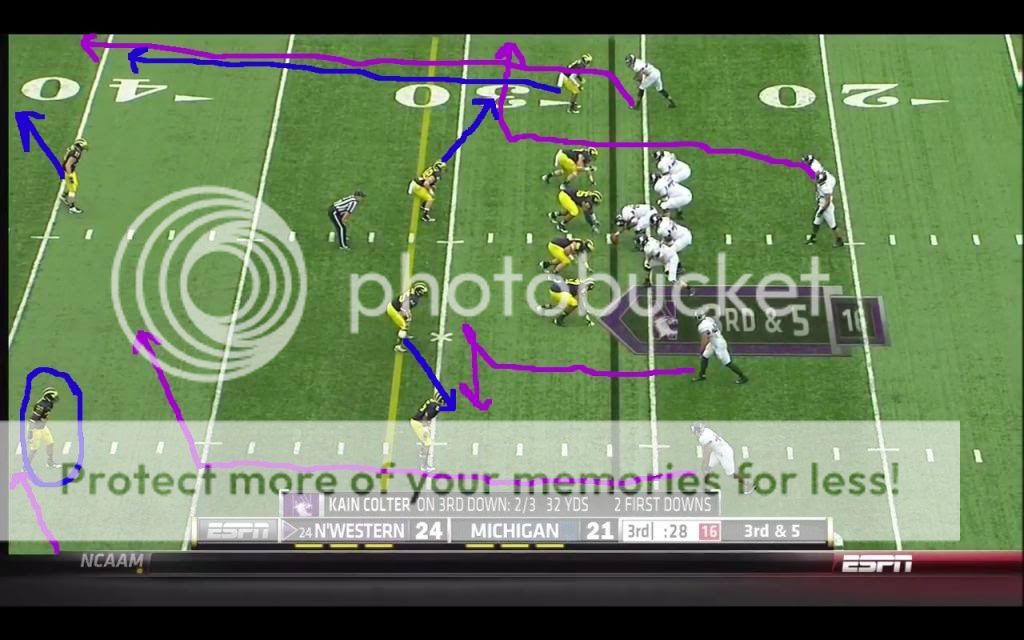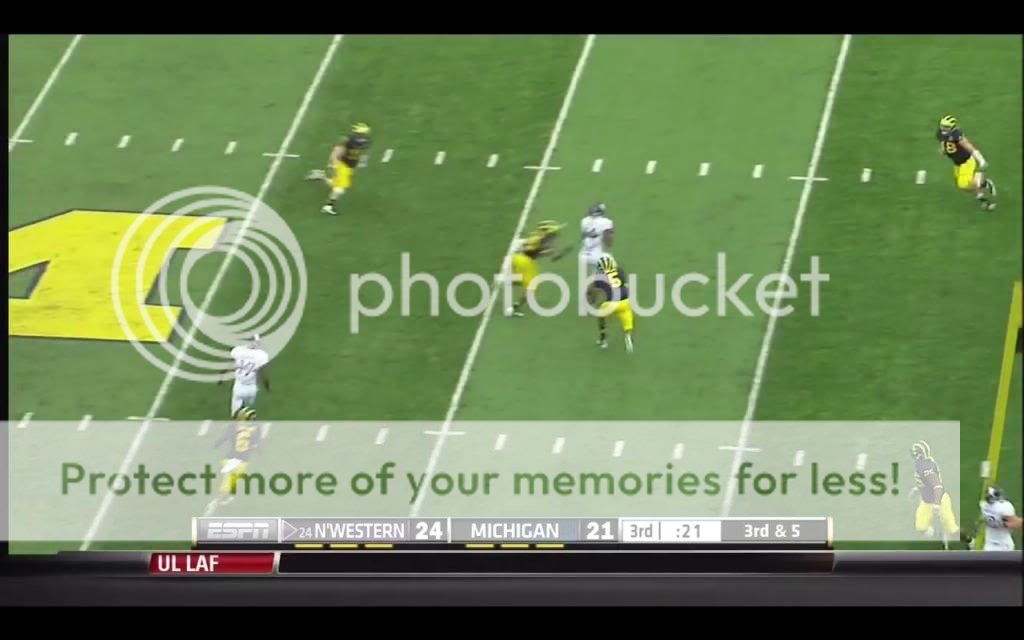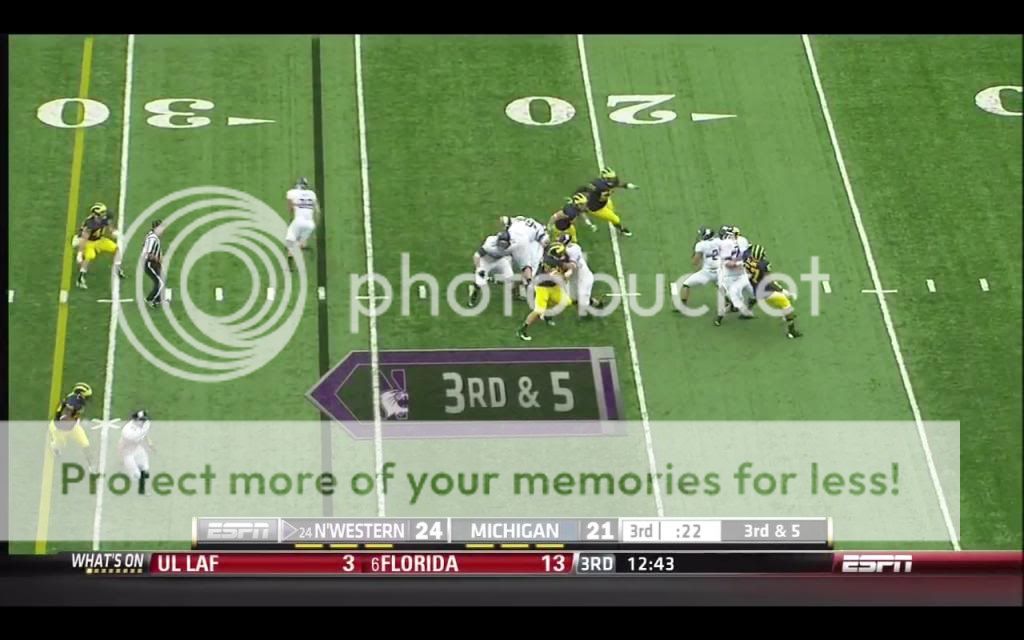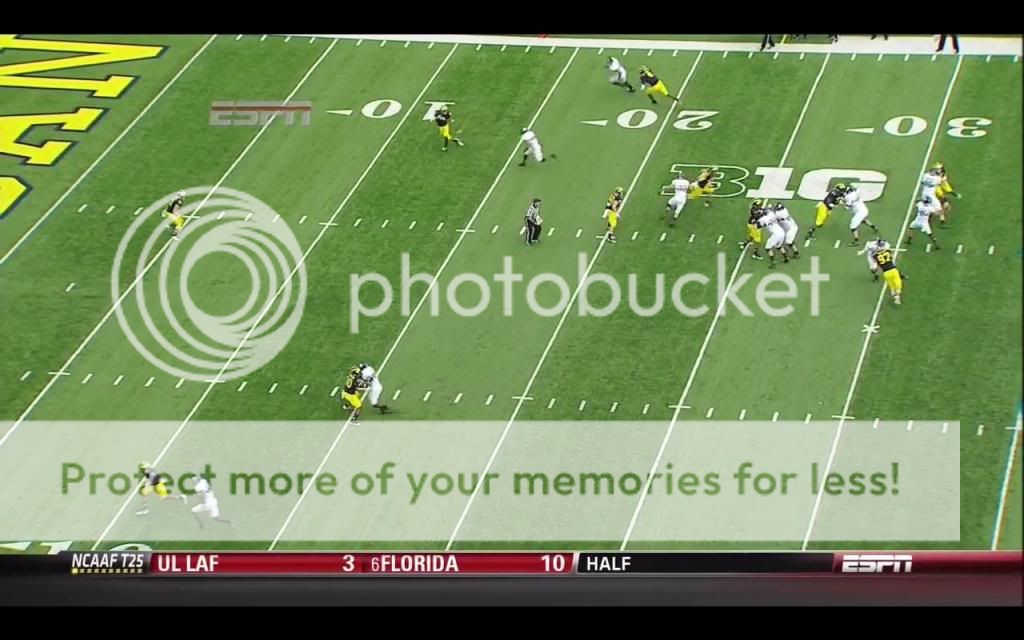Because of their potent run game, Northwestern faces a lot of zone defenses. Zone coverages are good against the run because every defender involved in coverage is watching the QB rather than chasing a man. Defenders always have their eye on the ball, and so will see the run developing. As a result, Northwestern's passing attack is mostly made up of popular zone-beating routes. They don't do anything especially innovative or confusing in the pass game. Rather, they use a number of tried and true concepts that distribute receivers in such a way as to create situations where one defender is left to defend two different players. They don't necessarily use the same plays as the Bear Raid, but a lot of what's said here has cross-over conceptually with what we do (and with what every team does against zone).
Like we probably will, Michigan ran a lot of split safety zone coverages in their game against the Wildcats, so I'll only talk about that game (MSU was the only other game I could get, and their DC pulled out a lot more stops in coverage). In that game, the most common individual passing concept that Northwestern used was the “flood” route. The basic premise of this kind of route is that most zone coverages have some number of defenders distributed evenly across the field playing deep zones, and some number of defenders spread evenly across the field playing underneath zones. The defense therefore has two levels: deep and underneath. If you run routes that attack three different levels, the defense should should have trouble accounting for them all. Because such routes require at least three receivers being in the same area, they are especially well-suited to Northwestern's favored 3x1 formation. One of their go-to pass plays on third down was the following:
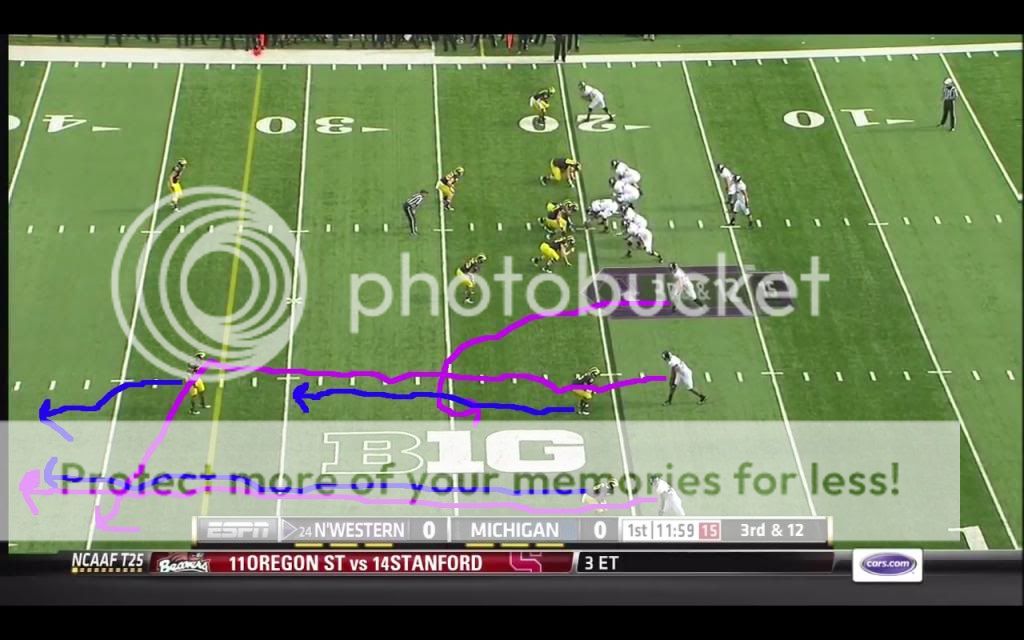
The deepest of the three routes is the go-route by the #1 receiver at the bottom of the screen (for the numbering of receivers, see this post: http://bearinsider.com/forums/showthread.php?t=74828). He's just running straight down the field, so he easily gets deeper than all the other routes. In actuality this guy will hardly ever get the ball. His job is just to take the deep coverage with him to ensure that the remaining underneath defender is isolated against the other two routes.
Michigan is probably running Cover-2 Read here. This is a 2-deep coverage, but it has the additional stipulation that the CB will chase #1 if he goes deep, as he does on this play. Now, because this is a form of Cover-2, the safeties are supposed to be providing deep help. When #1 pushes deep and #2 also looks like he's pushing deep, the safety has to back-pedal and stay with the deepest receiver, which makes it very hard for him to react to the corner route run by #2. At this point, therefore, the #1 receiver has taken the CB and the safety out of the play. The only other relevant defender is the nickel back lined up over #2, and that's who the QB reads. If that guy sinks with the corner route, then the QB hits the curl underneath him. If, on the other hand, the nickel back stays in underneath coverage to defend the curl, then the QB throws the corner to #2. There isn't a good camera angle of everything as Colter is making his read, but from this picture with the ball in the air we can see that the nickel didn't sink sufficiently with the #2 receiver, and so that's where Colter goes with the ball Since the ball is already in the air here the NB and LB have already started chasing. If we had a good shot from half a second earlier, it would be even clearer that this guy is wide open:
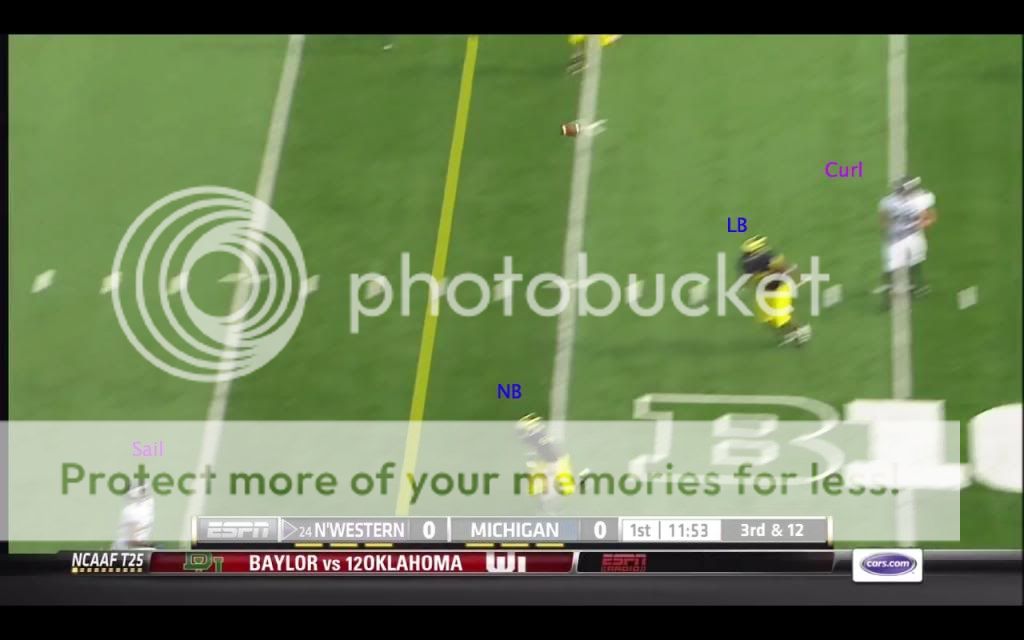
This route doesn't require the QB to make use of or read the entire field. It doesn't matter what the backside safety is doing or what the linebackers in underneath coverage are doing in the middle of the field. The deep coverage is nearly guaranteed to be out of the play because #1 runs a go-route, so all the QB has to do is read the underneath defender responsible for the curl-to-flat area, the nickel back in this case. If he stays shallow, the QB throws the deeper route. If he runs with the deeper route, the QB throws the shorter route. The offense “floods” the two outside zones with three receivers at three different levels, which standard zone defenses aren't well equipped to defend.
In other posts I've mentioned that Cover-3 is a coverage teams will go to to tighten up run defense. When teams do that, Northwestern likes to run a post-wheel concept, which seeks to isolate a deep defender instead of an underneath one. They ran this a bunch in both of the games that I watched:
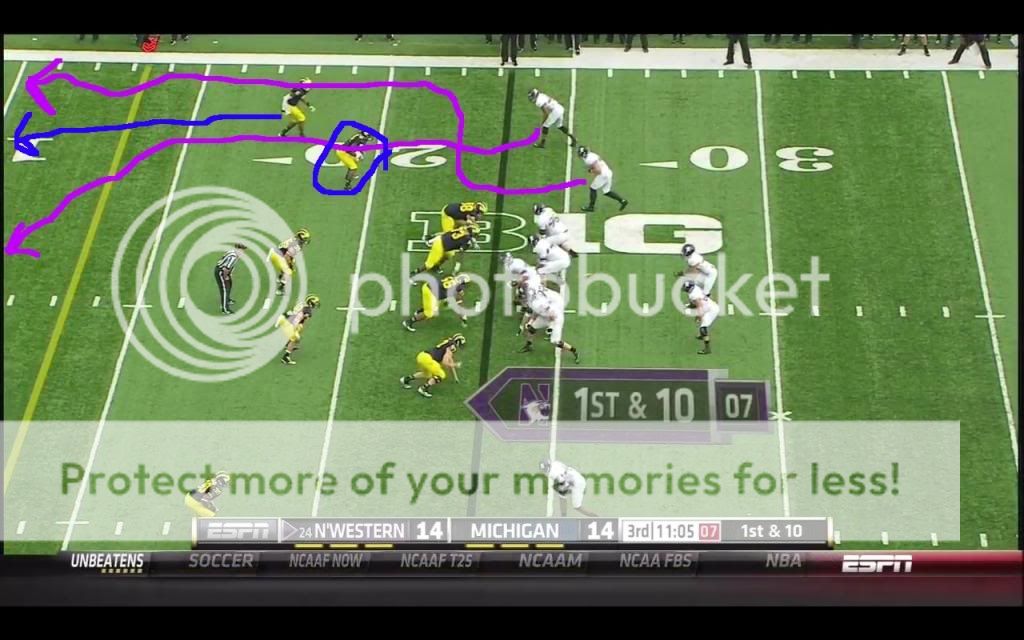
At the top of the screen, #1 is going to take an inside release and run a post while #2 runs a wheel route underneath him. To correctly defend this route, the LB that I've circled has to run with the wheel by #2. This is tough for him to do, because he's responsible for the outside zone in underneath coverage. This means that when #2 breaks out for the first part of the wheel route, the LB's thinking that he has to get underneath an out-route. When the receiver breaks down the field vertically, the LB really has to be prepared to make that second adjustment and get deep. If he doesn't, the CB playing his deep outside zone is stuck in between two deep routes and can not cover both:
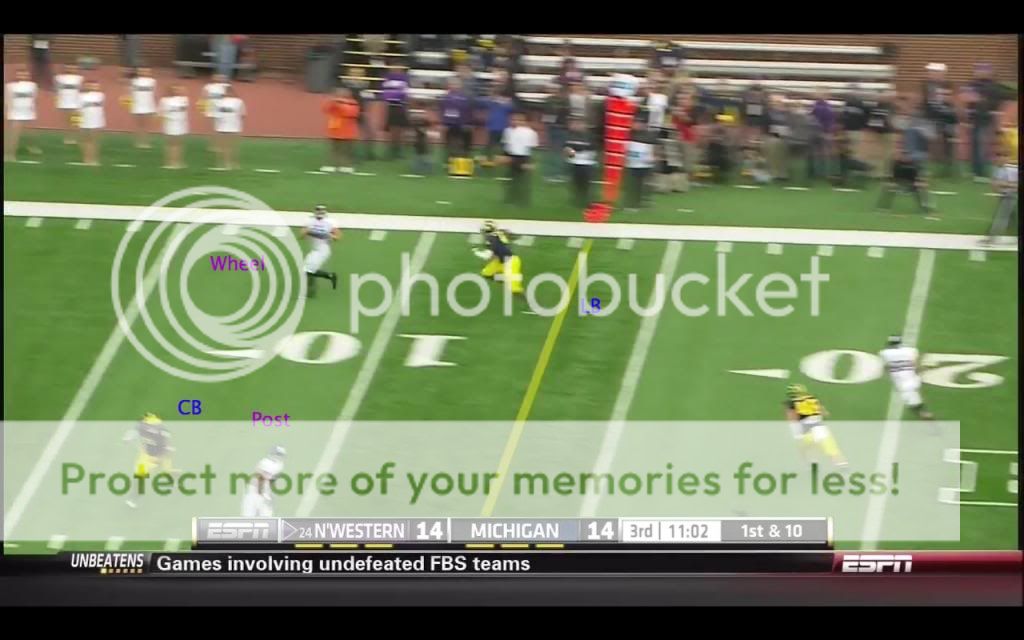
Here the CB runs with the post, the LB fails to run with the wheel, and the safety in the middle of the field doesn't have a chance. This goes for an easy TD.
Like we probably will, Michigan ran a lot of split safety zone coverages in their game against the Wildcats, so I'll only talk about that game (MSU was the only other game I could get, and their DC pulled out a lot more stops in coverage). In that game, the most common individual passing concept that Northwestern used was the “flood” route. The basic premise of this kind of route is that most zone coverages have some number of defenders distributed evenly across the field playing deep zones, and some number of defenders spread evenly across the field playing underneath zones. The defense therefore has two levels: deep and underneath. If you run routes that attack three different levels, the defense should should have trouble accounting for them all. Because such routes require at least three receivers being in the same area, they are especially well-suited to Northwestern's favored 3x1 formation. One of their go-to pass plays on third down was the following:

The deepest of the three routes is the go-route by the #1 receiver at the bottom of the screen (for the numbering of receivers, see this post: http://bearinsider.com/forums/showthread.php?t=74828). He's just running straight down the field, so he easily gets deeper than all the other routes. In actuality this guy will hardly ever get the ball. His job is just to take the deep coverage with him to ensure that the remaining underneath defender is isolated against the other two routes.
Michigan is probably running Cover-2 Read here. This is a 2-deep coverage, but it has the additional stipulation that the CB will chase #1 if he goes deep, as he does on this play. Now, because this is a form of Cover-2, the safeties are supposed to be providing deep help. When #1 pushes deep and #2 also looks like he's pushing deep, the safety has to back-pedal and stay with the deepest receiver, which makes it very hard for him to react to the corner route run by #2. At this point, therefore, the #1 receiver has taken the CB and the safety out of the play. The only other relevant defender is the nickel back lined up over #2, and that's who the QB reads. If that guy sinks with the corner route, then the QB hits the curl underneath him. If, on the other hand, the nickel back stays in underneath coverage to defend the curl, then the QB throws the corner to #2. There isn't a good camera angle of everything as Colter is making his read, but from this picture with the ball in the air we can see that the nickel didn't sink sufficiently with the #2 receiver, and so that's where Colter goes with the ball Since the ball is already in the air here the NB and LB have already started chasing. If we had a good shot from half a second earlier, it would be even clearer that this guy is wide open:

This route doesn't require the QB to make use of or read the entire field. It doesn't matter what the backside safety is doing or what the linebackers in underneath coverage are doing in the middle of the field. The deep coverage is nearly guaranteed to be out of the play because #1 runs a go-route, so all the QB has to do is read the underneath defender responsible for the curl-to-flat area, the nickel back in this case. If he stays shallow, the QB throws the deeper route. If he runs with the deeper route, the QB throws the shorter route. The offense “floods” the two outside zones with three receivers at three different levels, which standard zone defenses aren't well equipped to defend.
In other posts I've mentioned that Cover-3 is a coverage teams will go to to tighten up run defense. When teams do that, Northwestern likes to run a post-wheel concept, which seeks to isolate a deep defender instead of an underneath one. They ran this a bunch in both of the games that I watched:

At the top of the screen, #1 is going to take an inside release and run a post while #2 runs a wheel route underneath him. To correctly defend this route, the LB that I've circled has to run with the wheel by #2. This is tough for him to do, because he's responsible for the outside zone in underneath coverage. This means that when #2 breaks out for the first part of the wheel route, the LB's thinking that he has to get underneath an out-route. When the receiver breaks down the field vertically, the LB really has to be prepared to make that second adjustment and get deep. If he doesn't, the CB playing his deep outside zone is stuck in between two deep routes and can not cover both:

Here the CB runs with the post, the LB fails to run with the wheel, and the safety in the middle of the field doesn't have a chance. This goes for an easy TD.

